The AMD A8-3850 Review: Llano on the Desktop
by Anand Lal Shimpi on June 30, 2011 3:11 AM ESTEver since the arrival of Conroe back in 2006, we've only really recommended AMD for its (sometimes incredible) value. Recommending AMD for those looking for absolute performance pretty much ended when the Pentium 4 retired.
AMD is looking to change that with the arrival of its first Fusion APUs. These APUs marry one or more AMD x86 cores with dozens if not hundreds of Radeon "cores" on a single die. While today the APU is little more than a cohabitation of these two computing architectures, the end goal is something far more integrated:

Llano is AMD's second Fusion APU, the first being Zacate which we met earlier this year. Llano shouldn't be all that unfamiliar to you either, the notebook version of the APU launched just two weeks ago. Our conclusions were as you'd expect: sub-par x86 performance but competitive battery life and great gaming performance for a value notebook. If gaming is going to be the most intensive thing you do on your notebook, you may find yourself wanting one based on a Llano APU.
Now it's time to look at Llano on the desktop. We previewed the desktop Llano alongside the mobile version but today we're back with much more detail. This article will focus on the basics: CPU performance, GPU performance and the associated details. Ian has a final review of one of the first desktop Llano motherboards - the ASRock A75 Extreme6 as well as a look at overclocking the new desktop APU. Finally Ganesh's article takes an in-depth look at how Llano works as an HTPC platform.
The APU
Although mobile Llano has to worry about fitting into thin and light notebooks, the desktop version has a lot more breathing room and as a result it comes to us in a pretty traditional package. Motherboard backwards compatibility is thrown out the window as you need pins to get video output from the APU to an on-board VGA/DVI/HDMI header and as a result we have a new platform: Socket-FM1.
Socket-FM1 is a 905-pin ordeal that looks reminiscent of the original Clawhammer CPU:
Despite the socket change, heatsink specifications haven't changed. All existing Socket-AM2/AM2+/AM3/AM3+ heatsinks should work just fine as long as they can handle the rated TDP of the chip you're cooling.
The desktop Llano launch starts small. AMD is only introducing four parts today, two of which will be available later:
| AMD Llano Desktop Lineup | |||||||||
| GPU | Total TDP (GPU + CPU) | CPU Cores | CPU Clock (Base/Turbo) | GPU Cores | GPU Clock | Price | |||
| AMD A8-3850 | Radeon HD 6550D | 100W | 4 | 2.9GHz | 400 | 600MHz | $135 | ||
| AMD A8-3800 | Radeon HD 6550D | 65W | 4 | 2.4/2.7GHz | 400 | 600MHz | $?? | ||
| AMD A6-3650 | Radeon HD 6530D | 100W | 4 | 2.6GHz | 320 | 443MHz | $115 | ||
| AMD A6-3600 | Radeon HD 6530D | 65W | 4 | 2.1/2.4GHz | 320 | 443MHz | $?? | ||
The A8-3850 and A6-3650 are going to be the first Llano APUs available, both carry a 100W TDP rating. While this may seem high, do remember that 100W is for the CPU and GPU combined.
Although Llano does support AMD's new Turbo Core technology, neither of the parts launching today have it enabled. The A8-3850 and A6-3650 run at 2.9GHz and 2.6GHz, respectively. The 3800 and 3600 will drop base clock speeds to hit a lower TDP but allow you to turbo up depending on workload. For an explanation of how Turbo Core works, flip back to our mobile Llano article.
Pricing is pretty reasonable. For $98 you can buy an Athlon II X4 640 running at 3.0GHz. For $37 more AMD will sell you an A8-3850 APU, effectively determining the price of the integrated GPU. AMD expects to see desktops built around the A6 to sell for $500 - $600, and A8 based systems to go for between $600 and $700
| CPU Specification Comparison | ||||||||
| CPU | Manufacturing Process | Cores | Transistor Count | Die Size | ||||
| AMD Llano 4C | 32nm | 4 | 1.45B | 228mm2 | ||||
| AMD Thuban 6C | 45nm | 6 | 904M | 346mm2 | ||||
| AMD Deneb 4C | 45nm | 4 | 758M | 258mm2 | ||||
| Intel Gulftown 6C | 32nm | 6 | 1.17B | 240mm2 | ||||
| Intel Nehalem/Bloomfield 4C | 45nm | 4 | 731M | 263mm2 | ||||
| Intel Sandy Bridge 4C | 32nm | 4 | 995M | 216mm2 | ||||
| Intel Lynnfield 4C | 45nm | 4 | 774M | 296mm2 | ||||
| Intel Clarkdale 2C | 32nm | 2 | 384M | 81mm2 | ||||
| Intel Sandy Bridge 2C (GT1) | 32nm | 2 | 504M | 131mm2 | ||||
| Intel Sandy Bridge 2C (GT2) | 32nm | 2 | 624M | 149mm2 | ||||
Architecturally desktop Llano is no different than its mobile counterpart. These are all quad-core parts with updated 32nm cores, boasting a ~6% increase in IPC over their 45nm Athlon II predecessors. Each core has a private 1MB L2 cache for a total of 4MB per quad-core APU.
The GPU side isn't different architecturally either, you're still looking at a Sumo core derived from AMD's Radeon HD 5570. Desktop Llano is available with either 400 GPU cores or 320 cores (you can get the mobile part with only 240 cores enabled as well). While the mobile parts top out at 444MHz, the extra TDP available in a desktop chassis allows AMD to ratchet up the GPU clock to 600MHz for the A8-3850.
AMD calls the two GPU configurations the Radeon HD 6550D and 6530D. Just like you can with mobile Llano, you can also pair a desktop Llano APU with a discrete GPU to have them both run in an asymmetrical CrossFire mode (with limitations of course):
| AMD Radeon Dual Graphics Branding | ||||
| Discrete GPU | 6550D | 6530D | ||
| HD 6670 | HD 6690D2 | HD 6690D2 | ||
| HD 6570 | HD 6630D2 | HD 6610D2 | ||
| HD 6450 | HD 6550D2 | HD 6550D2 | ||
The Chipset
I hate to keep drawing comparisons between desktop and mobile Llano APUs but we also have two chipsets on the desktop side: A75 and A55. The A75 chipset is the high end option with 6 x 6Gbps SATA ports and 4 x USB 3.0 ports:
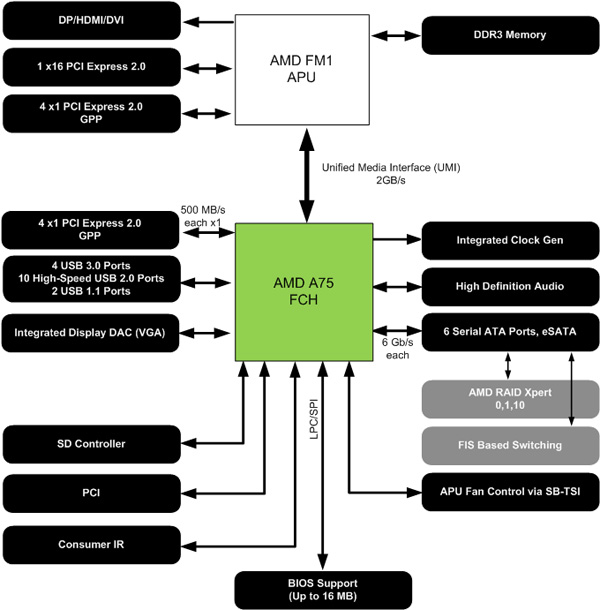
The A55 is the lower power, cost effective option that gets rid of all USB 3.0 support and backs down to 3Gbps SATA:
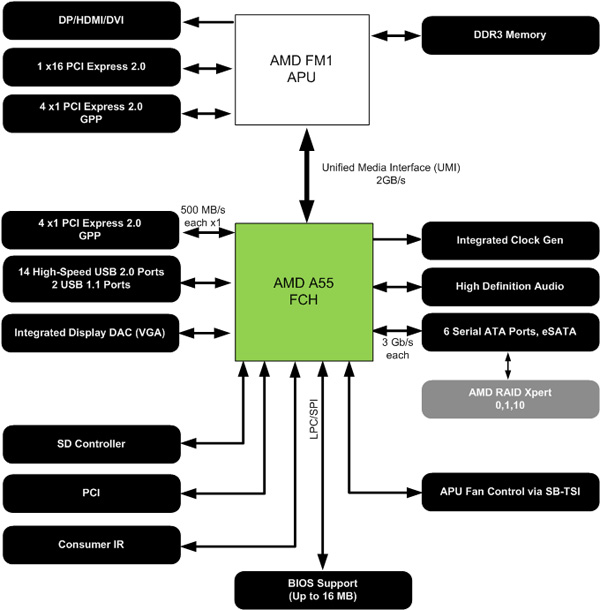


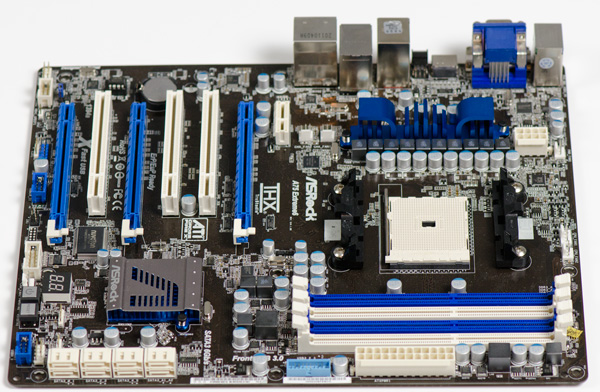
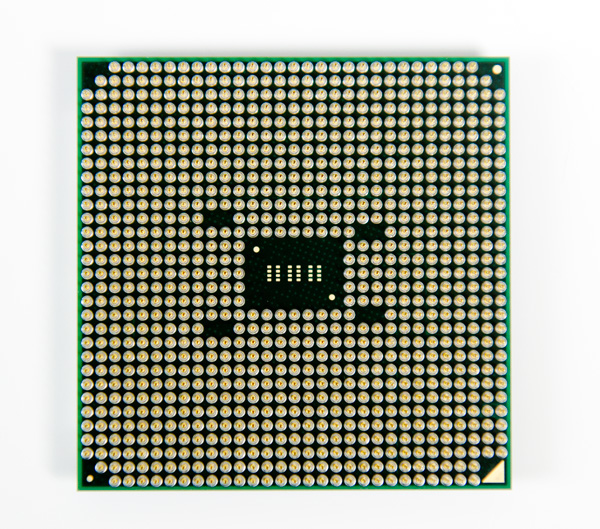
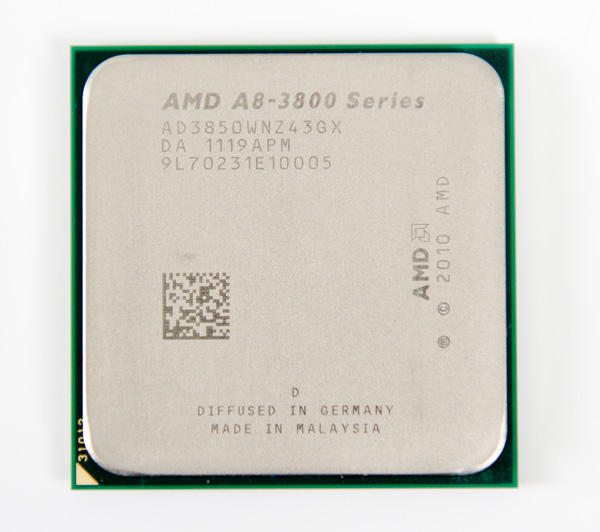
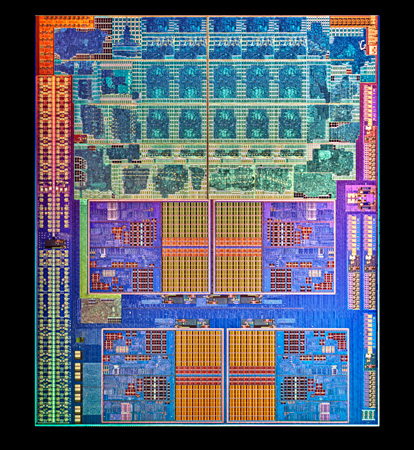








99 Comments
View All Comments
AnandThenMan - Thursday, June 30, 2011 - link
What happened to them, I thought it was stated that they will be up "in a few hours". And what about some DX11 tests, seeing Llano is capable, why not run a few DX11 games to see what it can do?crocin - Thursday, June 30, 2011 - link
Would be interesting to see how this A8-3850(150$?) will fair vs an intel pentium G840 + amd 5670(85$+70$=155$). Simply because these are the 2 options one would have when picking up a system with same money yeah?Also, wont this system would make so much more sense, if mobo makers came out with a 20$ motherboard w\o pci-e, hell no old school pci slots either. One 4gb ram slot of speeds upto 1866. Hmmm, that will bring AMD into the win for ultra cheap desktops. Or I am just crazy maybe. :p ANyway, always best part about AT is the technical part and the colorful graphs yey,
triclops41 - Thursday, June 30, 2011 - link
Slap this in a windows version of a Mac Mini and you have the coolest HTPC/portable 720p gaming system around. Almost as good as a PS3 or 360, tiny, quiet and versatile.JoJoman88 - Friday, July 1, 2011 - link
To me this just will not due for desktop at all. I can see the positives for notebooks and all but unless there is a greater range to crossfire with this is no use to me. Isn't that the problem with PS3 and 360, you are stuck with the video that the unit comes with at the time of purchase. Yes you could just pop in a better Fusion chip later and keep the rest of the system the same,that is better that what you can do with a PS 3 or 360. I have at least 5 AMD video cards that will smoke this thing.I know AMD will improve the Fusion line in the future. but they will never come even with the latest separate CPU and video card. Is Open CL really going to be that big of a deal that you will need the feature. I can't see this APU doing Open CL and gaming at the same time. Would, or do games use Open CL/Direct Compute at the the same time as Direct X. Would they not be using the same GPU at the same time and choke the system down.What about multitasking, you couldn't run a Open CL/Direct Compute at the same times as you were playing a DX game at the same time without killing the GPU Right ?!?
I just don't see what good except as others have said that this desktop stuff is aimed for OEM's to save money and raise the preformance of their lower end computers. I am open to that i'm totally wrong about how this works.
bhima - Saturday, July 2, 2011 - link
The Llano APU in a desktop just makes absolutely no sense as a budget gaming system unless you really only want the APU's graphics. Otherwise, if you are planning to actually buy a cheap discrete GPU you'll already surpass Llano's on-board offering with like a $50 board AND you won't be severely bottlenecked by their piss-poor performing CPU. The mobile Llano's make sense, but the desktop ones are just too damn gimped compared to the i3... the lowest performing Intel processor./yawn wake me up when Bulldozer gets here.
Aone - Sunday, July 3, 2011 - link
When you did the price calculation of Llano vs. Athlon you forgot to include MB price.Llano MB prices are >100$ today.
And IMO, Phenom X2+d.GPU is much better option for gaming PC than Athlon X4.
qqgoodhao - Sunday, July 17, 2011 - link
http://www.ifancyshop.comWomen's fashion, men's personality + shoes
Travel bagthat eye-catching jacket + super pack free shipping
zgoodbbb - Wednesday, July 20, 2011 - link
http://www.ifancyshop.comWomen's fashion, men's personality + shoes
Travel bagthat eye-catching jacket + super pack free shipping
Idanisi - Thursday, August 11, 2011 - link
would crossfire work with a nvidia video card?